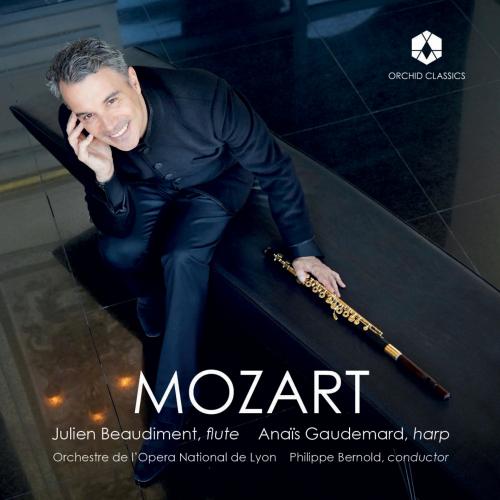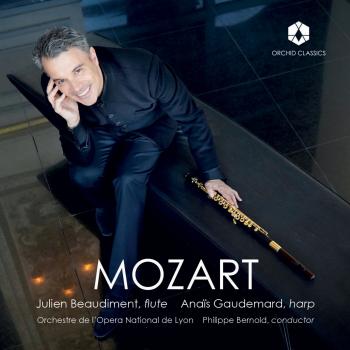
Album info
Album-Release:
2024
HRA-Release:
08.11.2024
Label: Orchid Classics
Genre: Classical
Subgenre: Concertos
Composer: Wolfgang Amadeus Mozart (1756-1791)
Album including Album cover
- Wolfgang Amadeus Mozart (1756 - 1791): Vorrei spiegarvi, oh Dio!, KV 418:
- 1 Mozart: Vorrei spiegarvi, oh Dio!, KV 418 06:22
- Flute and harp concerto, KV 299:
- 2 Mozart: Flute and harp concerto, KV 299: Allegro 09:35
- 3 Mozart: Flute and harp concerto, KV 299: Andantino 07:43
- 4 Mozart: Flute and harp concerto, KV 299: Rondeau 09:08
- Voi avete un cor fedele, KV 217:
- 5 Mozart: Voi avete un cor fedele, KV 217 06:22
- Six Variations on “Hélas j’ai perdu mon amant”, KV 360:
- 6 Mozart: Six Variations on “Hélas j’ai perdu mon amant”, KV 360: Thema Andantino 00:46
- 7 Mozart: Six Variations on “Hélas j’ai perdu mon amant”, KV 360: Variation 1 01:27
- 8 Mozart: Six Variations on “Hélas j’ai perdu mon amant”, KV 360: Variation 2 01:21
- 9 Mozart: Six Variations on “Hélas j’ai perdu mon amant”, KV 360: Variation 3 01:33
- 10 Mozart: Six Variations on “Hélas j’ai perdu mon amant”, KV 360: Variation 4 01:29
- 11 Mozart: Six Variations on “Hélas j’ai perdu mon amant”, KV 360: Variation 5 01:25
- 12 Mozart: Six Variations on “Hélas j’ai perdu mon amant”, KV 360: Variation 6 01:42
- Andante in C, KV 315:
- 13 Mozart: Andante in C, KV 315 04:51
- Rondeau in C, KV 373:
- 14 Mozart: Rondeau in C, KV 373 05:29
Info for Mozart
On the advice of his father, the young Mozart, 21 years old, went with his mother to Mannheim in 1777. This city at the time was one of the most famous European musical capitals. There were outstanding instrumentalists, patrons, an extraordinary orchestra, everything the young composer needed to expand his contacts, and find a stable profession as a composer in Mannheim. Once he arrived, he met the Weber sisters, Josepha, Aloysia and Constanze. Three muses with whom Mozart would fall in love successively, but only one was to be promised to him: Constanze. They were the love triangle of Mozart, and he dedicated the sublime Vorrei spiegarvi, oh Dio! to the soprano, Aloysia.
In this extraordinary concert aria, we find Mozart’s favourite love themes, both questions about fidelity, and epicurean love rivalry. The original tone of A major has been transposed here for this recording and my instrument into F major. The Mozartian genius is such that any vocal line transposes perfectly to other instruments. It took the precious help and talent of my friend Jean-Christophe Maltot to arrange this aria as a flute concerto, with certain passages requiring a virtuosic technical ability in order to keep the pure vocal line. Just like in the concert aria “Voi avete un cor fedele” where again, the protagonist’s love questions are directed towards her lover whom she considers unfaithful once the pleasure is consumed.
During his romantic stay in Mannheim, Mozart met the flautist, Ferdinand Dejean. Of Dutch origin, he lived in Mannheim, and asked Wolfgang to compose three concertos for him, as well as flute quartets. From this commission was born a concerto in G, four flute quartets, and a transcription of the concerto for oboe for the flute. The andante in C Major was intended to become the slow movement of the concerto in G. Then Mozart changed his mind and decided to keep this andante as a concert aria for the flute.
The rondo, originally composed for the violin in C major, was transposed by Hoffmeister into D major for the flute. In concert, it is very complicated to link the andante and the rondeau, to go from a key in C to D. By recording the original version in C for the first time on this album, and using a cadenza to connect these two pieces, it has been made possible to make the link between a slow and fast concert aria.
Mozart and his mother then left Mannheim for Paris, which then, was the great cultural capital of Europe. Mozart had already come to Paris at the age of 8 and had triumphed at the time and was therefore eager to return. Unfortunately, disappointment struck him. The city had changed, and Wolfgang also wrote to his father that Parisians are dirty and poorly educated. Have things really changed? As a Frenchman, I allow myself this touch of irony. His mother, Ana Maria, arrived in Paris seriously ill. Mozart tried to manage both fronts, the illness of his mother he loved so much, and his career. There he met the Duke of Guines, a diplomat, military, and amateur flautist, who commissioned him a concerto for flute and harp, as his daughter was also a harpist. From this meeting was born the famous concerto KV 299, which remains to this day a model of symphonie concertante, where the two instruments share the roles. The slow movement is one of the composer’s greatest pieces. With absolute lyricism and intimacy, it was written at the same time as the death of his mother in Paris. This tragedy marked a major turning point in the relationship between Mozart and his father, who reproached him for not having taken care of his mother enough by favouring his career.
The six variations on “Alas I lost my lover”, KV 360, is a work for violin and piano, composed in 1781 and dedicated to one of Mozart’s very first students, Marie-Karoline, Countess Thiennes de Rumbeke. This small masterpiece, here adapted for the harp and flute, is a beautiful love discussion between the two instruments, and the G minor key adds a pleasant melancholy, tinged with virtuosity.
The programme of this album is at the crossroads of voice and flute. I wanted to make the flute the most vocal, the most feminine, and the most loving as possible. It is a great privilege to record this album with my orchestra, the wonderful Anaïs Gaudemard, and Philippe Bernold, who was my predecessor to the same orchestra of the Orchestre de l’Opera National de Lyon. Philippe was fortunate to start his career in this orchestra with Sir John Eliot Gardiner, with whom he learned so much, especially about Mozart. It was a natural filiation for me to ask him to be the conductor of our beloved orchestra which turned 40 years old last year.
Julien Beaudiment, flute
Anaïs Gaudemard, harp
Opéra National de Lyon
Philippe Bernold, conductor
Julien Beaudiment
is considered as one of France’s leading flautists. After holding the position of principal flute of the prestigious Los Angeles Philharmonic under Gustavo Dudamel, Julien Beaudiment is today principal flute of the Orchestre de l’Opera National de Lyon and professor at the Conservatoire National Supérieur de Musique de Lyon. He has also held the same position with the BBC National Orchestra of Wales.
After his studies at the Guildhall School of Music and Drama in London with Paul Edmund-Davies, Julien entered the Conservatoire National Supérieur de music de Paris, where he won the first prize of flute in the class of Sophie Cherrier.
Julien plays now in the most beautiful halls in the world as a soloist and within the Berliner Philharmoniker, the Orchestra Simon Bolivar of Venezuela, the Estonian Festival, the London Symphony Orchestra, the London Philharmonic Orchestra, the Philharmonia, the Scottish Chamber Orchestra, the Academy of St. Martin in the Fields, the Hallé Orchestra, the Beijing Opera Orchestra, the Orchestre de Paris, the Orchestre de l’Opéra National de Paris and the NDR Orchestra in Hamburg. He performs under the direction of Sir Simon Rattle, Sir Antonio Pappano, Gustavo Dudamel, Esa Pekka Salonen, Sir Colin Davis, Paavo Järvi, Christoph Eschenbach, Michael Tilson Thomas, Vladimir Jurovski, Kirill Petrenko, Robin Ticciati, Charles Dutoit, Semyon Bychkov, Christian Zacharias, James Conlon, Sir Roger Norrington, William Christie, Ivan Fischer, and alongside musicians such as Joshua Bell, Murray Perahia and Itzhak Perlman, and the Hollywood star John Williams.
Anaïs Gaudemard
As an authentic ambassador for her instrument, Anaïs Gaudemard declared in her first album’s booklet featuring concertos by Boieldieu, Debussy and Ginastera on the Clavès records label: “I love the harp for all that is unknown about it, since for me it is limitless”, and she wanted to “unveil its wide sound repertoire”.
It did not take long before the soloist’s international fame was established, after being awarded the 1st Prize at the prestigious International Harp Competition in Israel 2012, as well as the 2nd and Prize of the Münchener Kammerorchester at the ARD Competition 2016 in Munich. Anaïs Gaudemard was also awarded the Thierry Scherz Prize at the Festival des Sommets Musicaux de Gstaad 2015 and nominated “ECHO Rising Star” 2018/19 by the Philharmonie de Paris and the Calouste Gulbenkian Foundation of Lisbon. Since then, she has made debuts on the most prestigious international stages, such as the Wiener Konzerthaus, Elbphilharmonie (Hamburg), Barbican Centre (London) and Concertgebouw (Amsterdam), among others. The Institut de France recently awarded her the Tissier-Grandpierre Prize in recognition of her career.
Anaïs Gaudemard plays with a Style 23 Gold Concert Grand harp, a gift from the Lyon & Healy harp makers that she received at the 18th International Harp Competition in Israel in 2012.
Philippe Bernold
began his musical studies in Colmar, France, studying the flute and later composition and conducting under René Matteer, himself a student of Charles and Fritz Münch. At the Paris Conservatory, he earned the First prize in flute and the next year, at the age of 23, was appointed first flute of the National Opera Orchestra of Lyon. In 1987 he won First Prize in the Jean-Pierre Rampal International Competition in Paris. This prize paved the way for an international solo career with renowned artists and orchestras, from Rostropovitch to Capuçon.
Orchestras with which he performed include those of Paris, Tokyo, Budapest or Moscow with such conductors as Menuhin, Gardiner, Maazel or Nagano. Mr. Bernold’s performances have taken him from Paris to Seoul, from London to Moscow, and to the principal festivals around the world.
In 1995, encouraged by his master J.E. Gardiner, he founded The Virtuosos of the Lyon Opera, with which he performed extensively thereafter. Since, he has conducted orchestras such as Sinfonia Varsovia, Simon Bolivar Orchestra, Zagreb Philharmonie, Orchestre de Chambre de Paris, Prague Philharmonia, Kanazawa Ensemble (Japan), Wiener Kammerorchester and Bogota Philharmonic Orchestra, to name a few.
Bernold’s first CD in 1989 won him the Grand Prize of the Charles Cros Academy. Since then, he has recorded more than 20 CD with Harmonia Mundi, EMI. Philippe Bernold is Professor of Chamber Music and Flute at the National Paris Conservatory.
This album contains no booklet.





